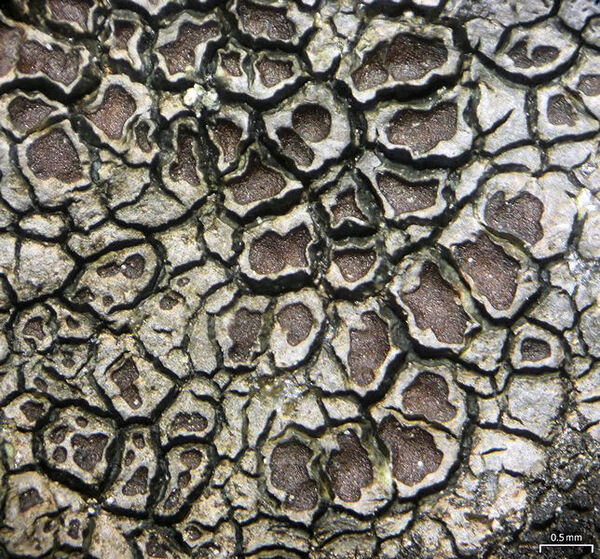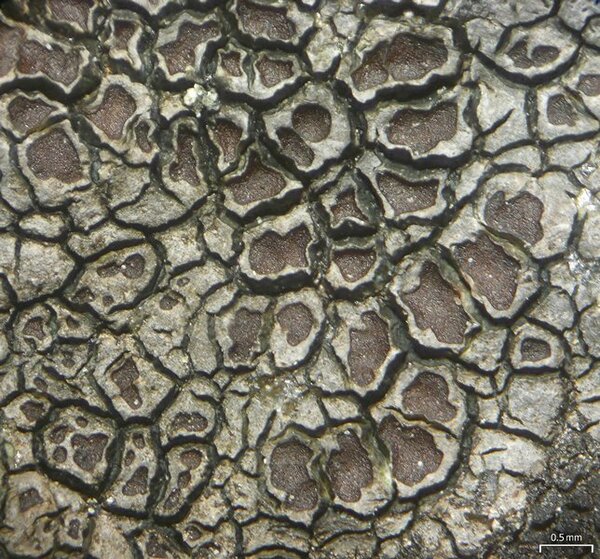Bellemerea sanguinea (Kremp.) Hafellner & Cl. Roux
in Clauzade & Cl. Roux, Bull. Soc. bot. Centre-Ouest, n. sér. 15: 129, 1984. Basionym: Aspicilia sanguinea Kremp. - Flora, 40: 371, 1857.
Synonyms: Lecanora sanguinea (Kremp.) Mig.
Distribution: N - TAA (Nascimbene & al. 2022), Lomb, Piem.
Description: Thallus crustose, episubstratic, rimose-areolate, pale to dark grey, forming more or less orbicular, up to 2(-4) cm wide patches, often delimited by a black prothallus. Areoles 0.3-0.7(-1) mm in diam., round to angular, flat to slightly convex. Cortex brownish to ash-grey in upper part, covered with a thin epinecral layer, without crystals; medulla white, I+ blue; algal layer extending below the hypothecium. Apothecia cryptolecanorine-aspicilioid, immersed, 0.2-0.7(-1.4) mm across, 1-2(-4) per areole, round to angular, with a concave to flat, reddish brown (when dry), or blood-red (when wet), epruinose disc, and a thin thalline margin. Proper exciple poorly developed, 10-15 µm thick, I+ blue, the uppermost cells brown; epithecium pale brown, N-; hymenium colourless, (65-)70-100 µm high, I+ blue; paraphyses branched and anastomosing in upper part, 1.5-2(-3) µm thick at base, the apical cells 3(-4) µm wide, usually with a thin, dark brown cap; hypothecium colourless, 30-50 µm high, I+ blue. Asci 8-spored, clavate, approaching the Porpidia-type, with a less distinct tube structure. Ascospores 1-celled, hyaline, ellipsoid, (11-)14-23 x 6-14 µm, the inner wall I+ blue, with a thin halonate epispore. Pycnidia rare, dark, immersed. Conidia short- bacilliform, c. 5 µm long. Photobiont chlorococcoid. Spot tests: thallus K-, C-, KC-, P-. Chemistry: without lichen substances.Note: characterised by a thin, rimose, grey thallus and aspicilioid dark-red apothecia, this species occurs on siliceous rocks, especially slightly calciferous schists, near or above treeline; it is closely related to B. diamarta.
Growth form: Crustose
Substrata: rocks
Photobiont: green algae other than Trentepohlia
Reproductive strategy: mainly sexual
Species of metal-rich rocks
Commonnes-rarity: (info)
Alpine belt: rare
Subalpine belt: rare
Oromediterranean belt: absent
Montane belt: absent
Submediterranean belt: absent
Padanian area: absent
Humid submediterranean belt: absent
Humid mediterranean belt: absent
Dry mediterranean belt: absent

Predictive model
Growth form: Crustose
Substrata: rocks
Photobiont: green algae other than Trentepohlia
Reproductive strategy: mainly sexual
Species of metal-rich rocks
Commonnes-rarity: (info)
Alpine belt: rare
Subalpine belt: rare
Oromediterranean belt: absent
Montane belt: absent
Submediterranean belt: absent
Padanian area: absent
Humid submediterranean belt: absent
Humid mediterranean belt: absent
Dry mediterranean belt: absent

Predictive model
 INDEX FUNGORUM
INDEX FUNGORUM
 GBIF
GBIF
 DOLICHENS
DOLICHENS



